
Jade Dragon Snow Mountain
China assaults the senses with a cacophony of sounds and colorful sights amid its teeming masses. As soon as we arrived in October for a month’s trip, the noxious smog of vehicle-packed Beijing assailed our nostrils. But the past still dwells in the shadows of the modernized capital. At dusk, a row of elderly stooped men shuffled along the road beneath our apartment in Mao-style uniforms. We would see the same gray men plodding by in the morning.
The contrast between affluence and poverty was very striking. The opulent Prince Gong Mansion adjoins the Hutong area of Beijing, where life is still primitive, without indoor plumbing. Our guide, David, grew up here in a one-room hut, but his family was later relocated. As for changing times, the steep demands of a future wife would likely comprise an apartment, a vehicle and expensive jewelry, he told us.
At an upscale mall with fountains, we shunned the crowd thronging the iPhone store to buy salad vegetables in a small supermarket. One department store had rows of stylish vaporizers steaming away — a necessary device considering the air quality. When I absentmindedly dropped my shawl on the mall plaza, a policewoman was beside me in a flash to return it. Big Sister was watching over us. We had similar moments elsewhere in China. When we bargained with a self-styled porter at a railway station, a security man appeared out of nowhere and violently shoved the coarse-faced fellow outdoors.
The TV and Internet censors were brutally efficient too. When a CNN news bulletin mentioned the imprisonment of a dissident in China, the screen promptly blacked out. Similarly, a nature program about crocodiles disappeared after mildly disparaging Chinese conservation efforts and the local yen for crocodile skin.
The Chinese we met seemed stoic about their restricted freedom. “We can do as we like,” one told me, “as long as we don’t speak about it in public.”
Shopping is a strenuous activity. In an indoor Beijing market, two diminutive teenage girls attached themselves to my husband, pulling him along with a “Hey Mister, Mister. Come over here. You gotta see this.” Bargaining, which is done on small calculators, requires stamina and endurance.
Tantalizing glimpses of traditional China sometimes filtered through. In a Beijing park we listened spellbound as a dignified trio of seniors gathered under the trees to sing haunting melodies accompanied by the time-honored two-stringed erhu. During a day trip to Souzhou, near Shanghai, we visited classic landscaped Chinese gardens with aristocratically furnished pavilions, and toured a factory with an exhibit of manual silk production.
The magnificent art treasures of northern China fascinated us so much that we spent eight hours inside the vast Forbidden City of Beijing. Its architectural features include raised entries to ward off the evil eye, the emperor dragon symbol, and the phoenix for the empress. Calligraphy exhibits were on handmade paper or silk, sometimes with minute lettering. One humorous painting showed a group of jolly fishermen at work. Some of the intricate craftsmanship was inspired by plum blossom, orchids, fruit and vegetables. We admired porcelain vessels, gold artifacts, lacquered wood and jewelry.
Alone that day, we developed a technique to navigate the throng heading to the subway. It helped to follow closely on the heels of the most aggressive pushers as they elbowed their way through. The next day we headed north for a day of intensive touring to the Great Wall, the Summer Palace and the Ming Tombs. Outside the town were piles of dried maize for the animals, roadside fruit stands, and tall chestnut trees. One restaurant was packed as it offered a special delicacy — donkey meat. After a short cable car ascent, we hiked energetically around the Great Wall, clambering up and down its uneven stone steps and towers, and then careening down to the bottom on an alpine slide.
At the Summer Palace of the emperors, we admired the marble boat once revamped by Dowager Empress Cixi from naval funds. Cixi’s life story features her remarkable transformation from a minor concubine of Emperor Xianfeng to the de facto ruler of China for half a century. What triggered her sudden ascent was presenting the emperor with his only son in 1856. Despite her utter ruthlessness and talent for political intrigue, Cixi’s shortcomings as national ruler ultimately led to China’s defeat in the Sino-Japanese War (1894-95), the decline of the Qing dynasty, and the 1911 revolution.
We had planned our schedule to be with Chabad for most Sabbaths, where we ate better than usual. At Chabad of Beijing, we met tourists from the U.K., Israel and South America - lawyers, business people, kashrut supervisors, high-tech workers, students of Chinese and acupuncture, and teachers at Chabad’s international school. One American couple, on a vegetarian tour, dined in Buddhist vegan restaurants, which are not sanctioned by Chabad.
As kosher travelers, a refrigerator was a basic necessity for us. When we found no minibar at our Lijiang hotel in south China, the manager rushed over early in the morning to help. Since his English was rudimentary, we used creative means to explain ourselves. After we showed him a minibar on the Internet, then clicked on the hotel ad, he finally understood the concept. We were still unpacking when employees hauled in a brand new fridge and plugged it in. Anxious to please his Western guests, the manager also arranged vegetarian items for us at breakfast such as plain steamed rice, salad vegetables and hard-boiled eggs. “What does ‘plain’ mean?” he asked. “Like this apple here,” I told him.
After Beijing we reached Xian, where we viewed the bell and drum towers and the restored city wall. After dark we took a bus to the Big Wild Goose Pagoda area with its fountains and music. The city layout has remained unchanged since the Tang dynasty (618-907 C.E.) when Xian had a strategic position on the Silk Road, the ancient trade route linking Central Asia and China. The next day we saw the life-sized terracotta soldiers that were discovered in 1974. They were meant to accompany self-appointed Emperor Qin (246-210 B.C.E.) in his afterlife, along with 48 childless concubines who were buried alive to entertain him. Many workers and artisans were also entombed with him to preserve the secrets of the mausoleum.
Qin’s main achievement was to unify northern China and expand his empire far southward. However, within three years of his death, the oppressed masses revolted, burning and destroying much of his ceramic army. A movie was shown to provide a historical perspective.
The Shaanxi Province History Museum had an impressive collection of skillfully crafted artifacts of bronze, silver, agate, brocade and celadon — valuable greenish porcelain. Memorable also were a bronze garlic-head shaped flask from the Han dynasty and ancient paper made of hemp fiber and ramie. We ate our food in the museum’s souvenir shop. I ordered jasmine tea, which was fragrant, delicious, and expensive. It comes unstrained with a stack of leaves at the bottom of the glass. As the Chinese reuse their tea leaves three times, I thriftily packed them away in a plastic bag for the long train ride. The waitress who came to clean up showed her consternation in an animated discussion with her colleague. We guessed the likely gist of her words: “I can’t believe it — that crazy white woman wolfed down all the tea leaves!” On overnight train trips, by the way, VIP tickets are best; otherwise you’ll have some strange bedfellows.
We proceeded to Shanghai, where the free museum has exhibitions showing pottery and jade throughout the ages and national costumes. We toured the old part of town, also venturing into back streets with courtyard houses and alleys. Then we boarded a night boat to see the spectacular riverside lights.
The last week in October brought us to the Yellow Mountains of Huangshan. Huang means yellow, though the hills are of dark granite. They are named for mountain-lover Emperor Huang, who went up to heaven from here. At night in the urban center we braved a local spa where we had a Chinese massage, a rough stimulating treatment that includes a head massage. Note that visitors going for a dip in the hot pools outdoors must guard their dry towels and rubber slippers religiously or they will be considered public property and exchanged for inferior articles.
Ellen, our young, energetic guide, led us on rigorous climbing of the stairways up and down the heights to view the craggy peaks and stunted pine trees that penetrated the mist. The next morning, with some hesitation, we joined the throng who rose at dawn to view the sunrise. Unsure that visibility had returned, we listened for signals from the Chinese guests before venturing out. Ellen, who was ready and waiting at 5:30 am, was quite put out by our lateness. We apologized, and after she steered us to the vantage point, we sent her back to bed and admired the view. Before leaving we visited an ink factory in Tunxi and also watched a tea ceremony. As Ellen’s parents were tea farmers, she was knowledgeable on the theme.
After heading south to Kunming and the nearby stone forest in Yunnan province, we spent Shabbat in Guangzhou, and then took a train to Guilin for the Li River cruise. The boat ride to Yangshou on the calm green water among the karst hills was relaxing and serene. The landscape featured water buffalo, phoenix-tailed bamboo and osmanthus trees. In Yangshou we watched a nighttime performance by the river that was staged on narrow rafts, where the performers seemed to float on the water.
The last stage of our trip was in Lijiang. Its famous Black Dragon Pool Park is framed by a snow-covered mountain range and fringed by willows and evergreens. The Naxi or Dong minority wears native costumes; women are garbed in blue aprons with baskets on their backs. Dongba, their pictographic script, is the only hieroglyphic alphabet still in use. Our evening outing was by taxi to Shuhe, a beautiful old village nearby. The canals running through its streets are crossed by small wooden bridges, and its small central square is most picturesque. The stores are fronted by decorative wooden carved doors.
Next was a day trip to Yulong, or the Jade Dragon Snow Mountain. From Yak Meadow the snowy peaks were spectacular. In the green hills below, Blue Moon Valley Lake is a lovely vista that includes manmade blue pools and waterfalls.
Art, artifice and natural beauty are three complementary aspects of China, a country of great variety.
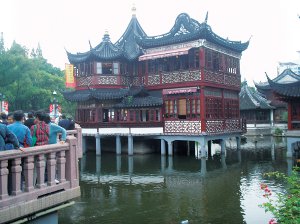
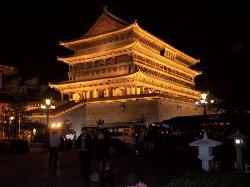
Shanghai, Yuyuan Xian, Drum Tower
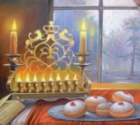 Chanukah 5773
Chanukah 5773 The Guild launches its season with The Fantasticks
The Guild launches its season with The Fantasticks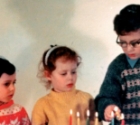 My Chanukiah
My Chanukiah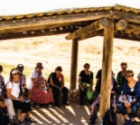 From Bible to Bedouins and Battles
From Bible to Bedouins and Battles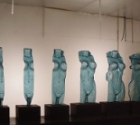 Trip to the Dead Sea
Trip to the Dead Sea Japan
Japan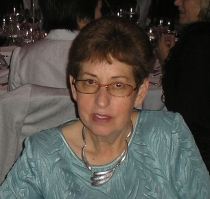 Susan de la Fuente
Susan de la Fuente